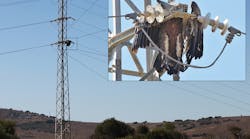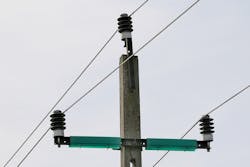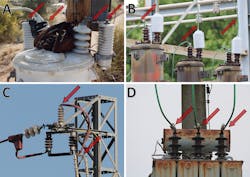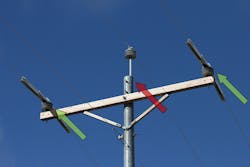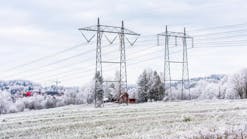Animal or bird contacts with power lines can result in outages, equipment damage, fires and fines from regulatory agencies. These factors can impact an electric utility’s relationships with customers as well as its financial bottom line. Business cases consistently show that retrofitting equipment to reduce wildlife contacts saves money over the long term, compared to the costs of reacting to unplanned forced outages, if retrofitting is completed thoroughly and correctly. Retrofitting typically involves the installation of cover-up materials to energized equipment to prevent phase-to-phase or phase-to-ground contact.
In North America, retrofitting materials most often are applied to pole-mounted equipment on wood poles. In Europe, retrofitting materials are applied to steel lattice or concrete pylons used to support lines and equipment. At first glance, the steel lattice and concrete pylons of Europe seem fundamentally different from North American configurations. However, that perspective misses the growing use of steel and concrete monopole structures in North American systems and misses the similarities between European pylons and the low side of many North American substations.
Forced outages caused by animal contact at substations can cause serious headaches and cost serious money. If we can learn from mistakes made in Europe, we can improve protections on North American systems without learning the hard way from mistakes we make ourselves.
In this article, retrofitting errors on grounded distribution pylons in Spain and Hungary are compared to very similar retrofitting errors on North American poles and substations. Some commonalities are identified that might help explain just how similar various overhead electric systems, problems and solutions can be, even though they seem quite different at first glance. This may help North American electric utilities to focus on keeping retrofitting cost-effective by avoiding expensive return visits to correct retrofitted errors on retrofitted poles.
Later this year, The Journal of Raptor Research will publish an article describing retrofitting errors on distribution poles in the United States, where raptors were electrocuted on poles described as “avian friendly.” To help electric utility personnel identify and correct retrofitting mistakes, the article will distinguish retrofitting errors as product design errors, mitigation plan errors and application errors.
Product Design Errors
Product design errors occur when products are not designed to fully cover energized components. New product design errors are decreasing on wood poles in North America because manufacturers actively encourage electric utilities using their products to provide feedback. Manufacturers then modify products based on that feedback, creating a loop of continually evolving and improving materials for retrofitting. Early-model products installed when they were considered “state of the art” can include product design errors, and therefore, awareness of the potential for these errors in legacy retrofitting can be important.
Cutout covers that leave the energized locking horns of cutouts exposed are a good example of a common product design error on distribution systems in North America. Product design errors in Europe can include deadend covers that do not fully cover the entire energized connector, linking primary wires to insulators, as well as steel crossarm covers that do not fully cover the entire arm. In both of these European cases, because primary wires remain exposed adjacent to grounded pylons, risks of animal contacts persist, despite the presence of retrofitting equipment.
Mitigation Plan Errors
Mitigation plan errors occur when some components on a pole are systematically retrofitted and others are not. These are the most common type of retrofitting errors, likely because advances in retrofitting materials move more quickly than many electric utility personnel have time to track, and in part because new materials take time to be approved by standards personnel. Therefore, even if an engineer knows of and wants to specify a new product, it may not be possible.
Mitigation plan errors occur widely in North America on distribution and substation equipment as well as widely in Spain and Hungary. One especially common example is the installation of bushing covers on transformers or other equipment without the installation of jumper covers; or vice versa, the installation of jumper covers without the installation of bushing covers.
Mitigation plan errors can be avoided if personnel involved in planning retrofitting and purchasing equipment make use of resources such as annual updates to product catalogs by manufacturers, and if they fully understand the Suggested Practices for Avian Protection on Power Lines produced by the Avian Power Line Interaction Committee (APLIC). The APLIC document is especially useful for utilities working to minimize contacts involving eagles, hawks and owls.
Application Errors
Application errors occur when retrofitting materials are correctly designed and specified, but are not correctly installed. According to the upcoming article in The Journal of Raptor Research, application errors occur less frequently than product design errors or mitigation plan errors. This may be because linemen working in the field are able to see better and avoid the creation of gaps in retrofitting as they work on actual installed equipment. In contrast, product manufacturers and electric utility personnel specifying equipment sometimes must take an educated guess at what installed equipment is likely to be encountered in the field and, thus, what retrofitting measures will be best.
Application errors do occur, however. In most cases, these errors are the result of very small gaps in retrofitting materials, which enable animals to make simultaneous contact with energized equipment. Examples in North America and Europe include jumpers that are not fully covered with split-seam insulation from end to end, or covered jumpers with insulation trimmed too much at the connection, resulting in bare wire extending outside of bushing covers. Gaps of less than 0.25 inches (6 mm) have been identified as responsible for animal contacts, so even minor in-the-field errors in workmanship — those barely visible from the ground — can undermine the effectiveness of a retrofitting program.
Another common application error, especially in substations, is the installation of bushing covers over the whole bushing instead of only over the top shed, as recommended by manufacturers. This error does not necessarily lead to an animal contact, but it does prevent rainwater from washing the lower sheds, potentially creating insulator contamination concerns.
Review and Learning
Implementing an effective retrofitting program can help electric utilities avoid outages, equipment damage, fires and fines. This is especially true as North American utilities move toward increasing grounding with the use of steel and concrete poles with steel crossarms, thus increasing the risk of phase-to-ground animal contacts. No matter which broad category they fall into — product design errors, mitigation plan errors and application errors — retrofitting errors can be avoided.
For example, product manufacturers can be informed of potential problems and often readily work to correct them. In many cases, alternative products are also marketed by competing manufacturers, with samples readily available for review and fit-testing by electric utility personnel. Early feedback from linemen working with samples in training yards can be helpful, especially to personnel specifying retrofitting equipment, because products designed to be installed, removed and replaced with a hot stick may not work as well for a specific utility as they do on paper.
Mitigation plan errors can be avoided through keeping up with the latest advances in retrofitting products.
Application errors can be avoided, too. Installation crews can benefit from having retrofitting work evaluated by someone broadly experienced in these issues, particularly early in a retrofitting program before initial mistakes become habitual. Such an evaluation may be most effective if it is conducted by outside personnel familiar with a wide variety of potential pitfalls and solutions, including errors in retrofitting found throughout North America and in Europe. This type of broad experience with a wide variety of errors can help electric utilities minimize retrofitting errors, and thus maximize the cost-effectiveness of retrofitting, especially when new structure designs like steel or concrete poles are introduced into an electric system.
If errors are found early in a retrofitting program, crews might still be in the area and can correct the errors relatively inexpensively. This may help to avoid costly return trips in response to animal contacts. Such trips undermine cost-effectiveness. They also have the potential to undermine crew morale and customer confidence.
If errors are found later in a retrofitting program, it might be most cost-effective to prioritize correcting errors in particularly high-risk areas, such as around raptor nests. Lower-risk errors might be allowed to persist until poles are accessed for other reasons, assuming retrofitting materials are kept stocked in trucks and warehouses, and crews remain vigilant to and
respond to errors as they are encountered.
For utilities that do not have a retrofitting program in place yet, a risk assessment is recommended to identify the specific types of animal contacts likely to occur as well as the most effective proactive and reactive mitigation practices to implement for addressing those potential contacts. ♦
Acknowledgements
The authors thank José J. Aniceto of the Regional Government of Andalucía, Spain; Péter Tóth of MME BirdLife, Hungary; and Rick E. Harness of EDM in the U.S. for discussions of power lines and substations in North America and Europe.
James Dwyer is a certified wildlife biologist and an environmental scientist at EDM International Inc. He works with electric utilities throughout North America and in Europe to develop decision-relevant science and wildlife research to answer specific electric utility-related questions and to facilitate environmentally responsible industrial and utility operations.
José Rafael Garrido López has been the head of wildlife monitoring and management programs at the Environmental and Water Agency of the Regional Government of Andalucía since 2006. Garrido designs and implements mitigation strategies to reduce negative interactions between birds and power lines in Spain and North Africa.
Justo Martín works as a biodiversity consultant for both private and public institutions in Spain and is involved in several projects related to power facilities and power lines and their effects and consequences for birds. Martín has broad experience designing monitoring and management plans for avian conservation.
Márton Horvath has coordinated Hungary’s national programs against the illegal poisoning of birds since 2006 and also coordinated the country’s programs against the electrocution of birds from 2006-2011. Since 2001, Horváth has served as MME BirdLife International’s Hungary national species conservation manager for imperial eagle conservation and is the manager of an international LIFE nature project.
